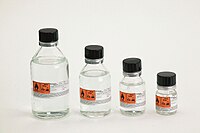
Photo from wikipedia
Some organosilicon compounds, including alkoxysilanes and siloxanes, proved effective in stabilizing the dimensions of waterlogged archaeological wood during drying, which is essential in the conservation process of ancient artifacts. However,… Click to show full abstract
Some organosilicon compounds, including alkoxysilanes and siloxanes, proved effective in stabilizing the dimensions of waterlogged archaeological wood during drying, which is essential in the conservation process of ancient artifacts. However, it was difficult to determine a strong correlation between the wood stabilizing effect and the properties of organosilicon compounds, such as molecular weight and size, weight percent gain, and the presence of other potentially reactive groups. Therefore, to better understand the mechanism behind the stabilization effectiveness, the reactivity of organosilicons with wood polymers was studied using a 2D 1H–13C solution-state NMR technique. The results showed an extensive modification of lignin through its demethoxylation and decarbonylation and also the absence of the native cellulose anomeric peak in siloxane-treated wood. The most substantial reactivity between wood polymers and organosilicon was observed with the (3-mercaptopropyl)trimethoxysilane treatment, showing complete removal of lignin side chains, the lowest syringyl/guaiacyl ratio, depolymerization of cellulose and xylan, and reactivity with the C6 primary hydroxyls in cellulose. This may explain the outstanding stabilizing effectiveness of this silane and supports the conclusion that extensive chemical interactions are essential in this process. It also indicates the vital role of a mercapto group in wood stabilization by organosilicons. This 2D NMR technique sheds new light on the chemical mechanisms involved in organosilicon consolidation of wood and reveals what chemical characteristics are essential in developing future conservation treatments.
Journal Title: Molecules
Year Published: 2022
Link to full text (if available)
Share on Social Media: Sign Up to like & get
recommendations!